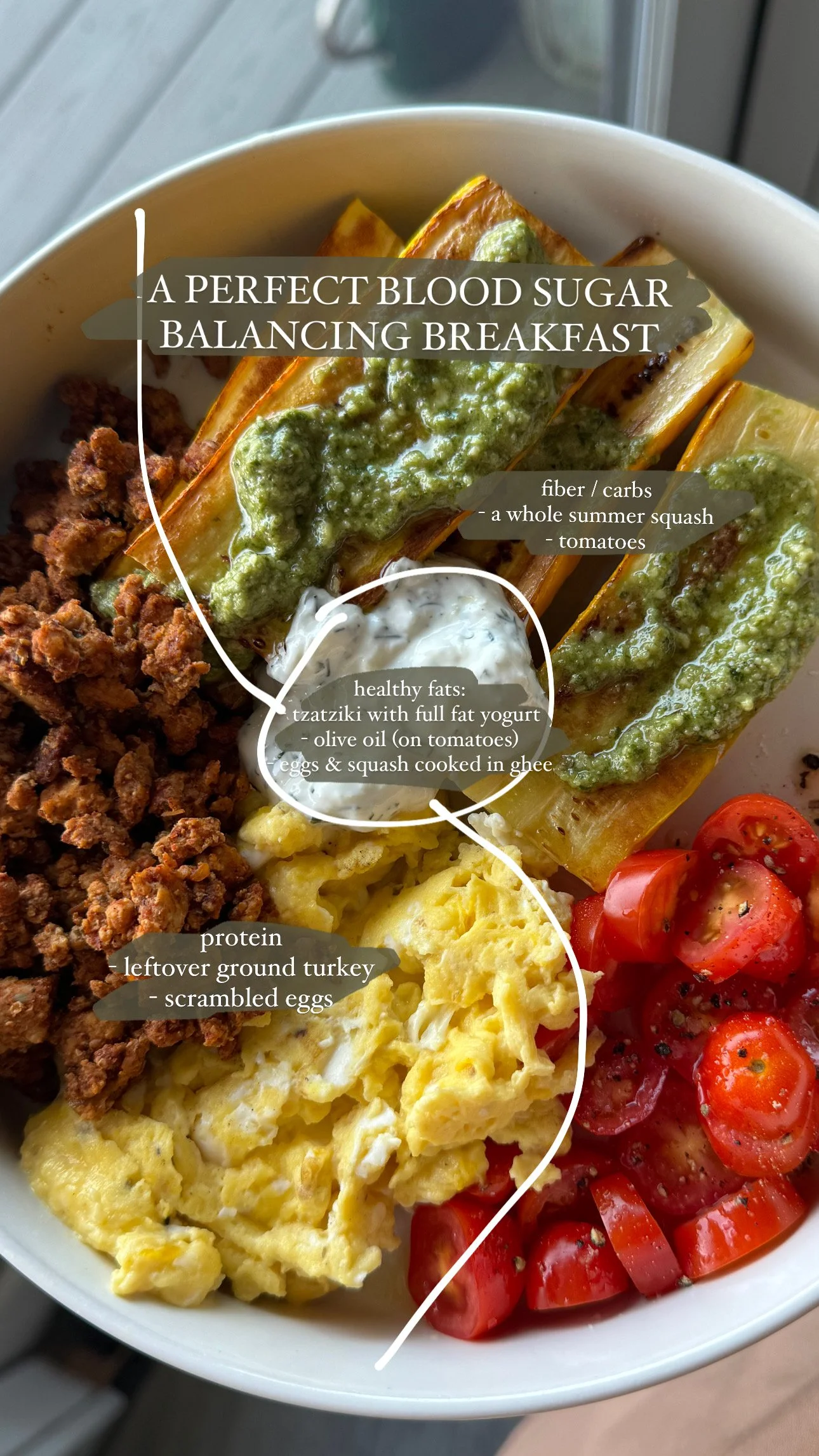Blood sugar 101 and how to create a balanced plate
Learning how to eat for blood sugar balance has truly changed my life. I used to wonder why I was ALWAYS HUNGRY. Why I had such intense cravings for sugar and carbs. Why I was hangry and moody between meals. Or why I would get sleepy after a big meal. All of this is related to blood sugar balance! Or improper blood sugar balance…
Once you start leveling out those blood sugar spikes and get off that sugar high/sugar crash cycle you will feel so energized, satiated, focused and grounded. Your digestion will improve, your hormones will start to balance and your inflammation will disappear.
SYMPTOMS OF POOR BLOOD SUGAR BALANCE
Sugar and carb cravings
Can’t make it 3-6 hours between meals without being hangry, moody, or crashing
Constant crashing
hormone imbalances, especially a PCOS diagnosis
Inflammation and feeling swollen
Digestion and gut issues
Brain fog, concentration issues
BLOOD SUGAR 101
What is blood sugar?
Blood sugar, or glucose, is the primary source of energy for the body’s cells. It comes from the food we eat, especially carbohydrates, and is transported through the bloodstream to cells, where it is used for energy. The hormone insulin, produced by the pancreas, helps regulate blood sugar levels by facilitating the uptake of glucose into cells. Excess glucose that is not used immeditaley used for energy or stored as glycogen is stored in the body as fat.
Blood sugar can get out of balance due to several factors, such as a poor diet, especially one high in simple carbohydrates and sugar. Other factors that can affect blood sugar balance are lack of exercise, stress, illness, or insufficient insulin production or use by the body.
Regularly consuming a diet high in simple carbs and sugar can lead to inflammation, insulin resistance (a precursor to diabetes), hormone imbalances and more.
Insulin resistance and poor blood sugar balance affects on women’s hormones
Poor blood sugar balance and insulin resistance can significantly impact female hormones. Insulin resistance occurs when the body's cells don't respond properly to insulin, leading to elevated blood sugar levels. This can disrupt the delicate balance of hormones in the body, particularly affecting estrogen and progesterone.
1. Polycystic Ovary Syndrome (PCOS): Insulin resistance can contribute to PCOS, a condition characterized by irregular menstrual cycles, ovarian cysts, and elevated levels of male hormones (androgens), leading to symptoms like acne, excess hair growth, and weight gain.
2. Menstrual Irregularities: Poor blood sugar balance can lead to irregular or missed periods due to hormone imbalances.
3. Fertility Issues: Hormonal imbalances caused by insulin resistance can interfere with ovulation, making it difficult to conceive.
4. Premenstrual Syndrome (PMS): Blood sugar fluctuations can worsen PMS symptoms, such as mood swings, fatigue, and cravings.
So how do you actually balance your blood sugar?
Eating Balanced Meals: at every meal (and snack!) you should have a protein, fiber rich vegetables/complex carbs and healthy fats on your plate.
Regular Exercise: Physical activity helps improve insulin sensitivity and allows cells to use glucose more effectively, especcially strength training.
Consistent Eating Schedule: Eating regular, balanced meals can prevent large spikes and drops in blood sugar.
Staying Hydrated: Drinking enough water helps the kidneys flush out excess sugar. Add a pinch of mineral rich salt to your water!
Choosing High-Fiber Foods: Foods high in fiber, like vegetables, whole grains, and legumes, slow the release of sugar into the bloodstream.
Walking after meals helps your body immediately use the glucose you just consumed which reduces the amount of sugar in the blood. Interestingly, your calf muscles are super effective at processing glucose!
HOW TO CREATE A BLOOD SUGAR BALANCING PLATE
Half your plate should be fibrous non starchy vegetables
Think leafy greens, summer squash, zucchini, cucumber, carrots, broccoli, cauliflower, Brussel sprouts, mushrooms, onions, radishes, artichoke, asparagus. The list goes on!
One quarter or more should be protein
Essential for your blood sugar balance! You always need a protein!
One quarter or less can be carbs or starchy vegetables
Sweet potato, potato, acorn or butternut squash. If choosing grains, choose gluten free grains to protect gut health and lower inflammation. Quinoa, buckwheat, rice, gluten free pastas.
A small portion should be healthy fats
Think 2-3 tablespoons of fats. This includes the fats your meat or vegetables are cooked in as well as fats in your dressing or marinades.
Try to include an Omega3 rich fat at each meal too (olive oil, avocado or avocado oil, salmon)
Remember that every body is different! This visual is there to help you! But you might require more protein or fat or carbs to feel your best! Or depending on what phase of your cycle you’re in, you might need more. For instance, during my menstrual phase, I feel better eating more grains than during other parts of my cycle.
BLOOD SUGAR BALANCING PLATE EXAMPLES
4 BLOOD SUGAR BALANCING SNACKS IDEAS
If your meals are truly balancing your blood sugar, you should be satiated and energized for 4-6 hours depending on your body. Remember everyone is different! Another good sign you’re eating enough of the right things is that you roll into the next meal gently. Your hunger cues turn on slowly. If you are suddenly STARVING and hangry, try adding in more protein, fat or fiber.
Now that being said, sometimes we all need a snack to hold us over to the next meal! Here are some great ideas that should keep your balanced.
Hardboiled eggs + banana with nut butter and cinnamon
Chomps Turkey protein stick + hummus and veggies
Greek yogurt bowl with fruit, grain free granola, cinnamon and dash of honey
Simple Mills organic gluten free seed crackers, turkey roll ups, cheese and fruit






